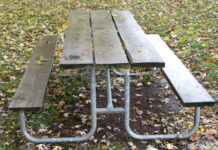Photo credit: DiasporaEngager (www.DiasporaEngager.com).
Investigation and Results
The Hawaii Department of Health conducted a cluster investigation across three fitness facilities. The index patient, fitness class participants, and facility staff members were interviewed using a standardized questionnaire; clinical and SARS-CoV-2 molecular test records were reviewed; and on-site facility assessments were conducted. This activity was reviewed by CDC and was conducted consistent with applicable federal law and CDC policy.†
The index case occurred in a male fitness instructor (instructor A) aged 37 years. Instructor A reported onset of fatigue on the evening of June 29 (Figure). The next day, he reported chills, body aches, cough, congestion, sore throat, and headache. On July 1, he received a positive SARS-CoV-2 RT-PCR test result.
Before his symptoms began, instructor A taught classes at two fitness facilities (facilities X and Y) on June 27, 28, and 29 (Table 1). On the morning of June 27, >2 days (60 hours) before symptom onset, instructor A taught a 1-hour yoga class for 27 participants at facility X. Instructor A wore a mask, but no participants wore masks. No participants reported symptoms during the next 14 days.§ Only one (4%) participant received SARS-CoV-2 RT-PCR testing, with a negative result, on July 3. Thus, the attack rate for facility X on June 27 was 0% (zero of 27) (Table 2).
On June 28, less than 2 but more than 1 day (38 hours) before symptom onset, instructor A taught a 1-hour high-intensity stationary cycling class for 10 participants at a second facility, facility Y. Instructor A and participants followed facility Y’s protocol and did not wear masks during exercise (2). The stationary cycling room measured 24 ft by 17 ft (408 sq ft). Doors and windows were closed, and three large floor fans were directed toward the participants for cooling. Instructor A was on a pedestal facing participants, shouting instructions and encouragement. Instructor A was >6 ft away from participants, and cycling stations were ≥6 ft apart. Among 10 participants, four had exposure to instructor A only during this class; all four received negative SARS-CoV-2 RT-PCR test results during July 3–4 (attack rate = 0% [zero of four]). Six participants had additional exposure to instructor A the next day.
On June 29, 4 hours before symptom onset, instructor A taught a 1-hour stationary cycling class with 10 participants at facility Y in the same format and room as that on June 28 (Table 1). No one wore masks while exercising. Six of the participants were those who had exposure to instructor A the previous day, and four participants had no exposure the day before. All 10 participants received positive SARS-CoV-2 RT-PCR test results during July 2–6 (attack rate = 100% [10 of 10]) (Table 2). Among these 10 cases at facility Y, seven occurred in women, seven patients identified as Asian and three as Native Hawaiian or Pacific Islander, and their median age was 37 years (range = 31–50 years). All patients were symptomatic, one of whom was another fitness instructor, instructor B.
Instructor B, a man aged 46 years, worked as a personal trainer at a third facility, facility Z. On the evening of July 2, 4 days after his first exposure to instructor A, instructor B reported body aches and sore throat with progression of symptoms, including fever, chills, cough, shortness of breath, and fatigue. On July 4, instructor B received a positive RT-PCR test result for SARS-CoV-2; he was later hospitalized and required admission to an intensive care unit.
On June 30, 2 days after first exposure at facility Y and ≥2 days before his symptom onset, instructor B taught five personal training and small-group kickboxing sessions with 10 participants and a participant caregiver at facility Z. For six participants (three in the morning and three in the afternoon), June 30 was their only exposure to instructor B. Sessions were 1 hour in duration, and physical distancing was not maintained except by the caregiver. Everyone in morning personal training sessions, including instructor B, wore a mask. No one in the afternoon kickboxing sessions, including instructor B, wore a mask. One of these participants received a negative SARS-CoV-2 molecular test result on July 6; five reported no symptoms during the next 14 days (attack rate = 0% [zero of six]) (Table 2). Four participants and the caregiver had additional exposure to instructor B on July 2.
On July 1, less than 2 but more than 1 day (36 hours) before symptom onset, instructor B provided personal training to four different participants at facility Z. No one wore masks. Among these four participants, one reported no symptoms in the next 14 days, and two received negative test results (one on July 6; one on both July 8 and July 16), and one received a positive SARS-CoV-2 RT-PCR test result on July 6 (attack rate = 25% [one of four]).
On July 2, 12 hours before symptom onset, instructor B taught 10 participants (one personal training and three kickboxing sessions with nine participants) with the caregiver present (11 exposed persons); four participants and the caregiver also participated in sessions on June 30. This was the only exposure to instructor B for the other six persons. Instructor B did not wear a mask. Two participants wore masks; both were infected. One had exposure on both June 30 and July 2, and one had exposure only on July 2. All received SARS-CoV-2 RT-PCR testing, and nine participants and the caregiver received positive results during July 6–8. The attack rate was 91% (10 of 11).
Among 11 cases from facility Z, seven were in women, seven patients identified as Asian, three as White, and one as Native Hawaiian or Pacific Islander, and their median age was 61 years (range = 53–81 years). Two (18%) participants had Parkinson disease. Ten patients were symptomatic, and one was hospitalized and required admission to an intensive care unit. The aggregate attack rates for both instructors by timing of exposure relative to their symptom onset dates were 0% (zero of 33), 13% (one of eight), and 95% (20 of 21), for exposure ≥2 days, <2 days to 1 day, and <1 day before symptom onset respectively (Table 2).
Source of original article: Centers for Disease Control and Prevention (CDC) / MMWR (Journal) (tools.cdc.gov).
The content of this article does not necessarily reflect the views or opinion of Global Diaspora News (www.GlobalDiasporaNews.com).
To submit your press release: (https://www.GlobalDiasporaNews.com/pr).
To advertise on Global Diaspora News: (www.GlobalDiasporaNews.com/ads).
Sign up to Global Diaspora News newsletter (https://www.GlobalDiasporaNews.com/newsletter/) to start receiving updates and opportunities directly in your email inbox for free.





























